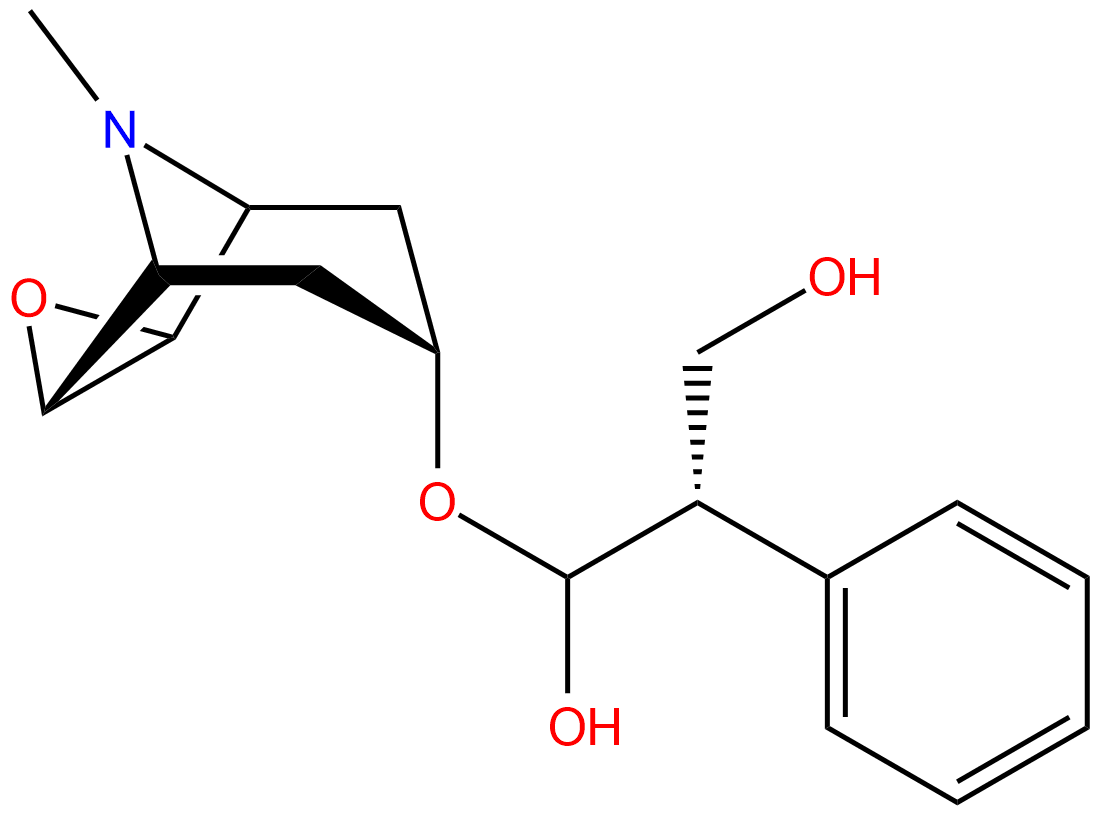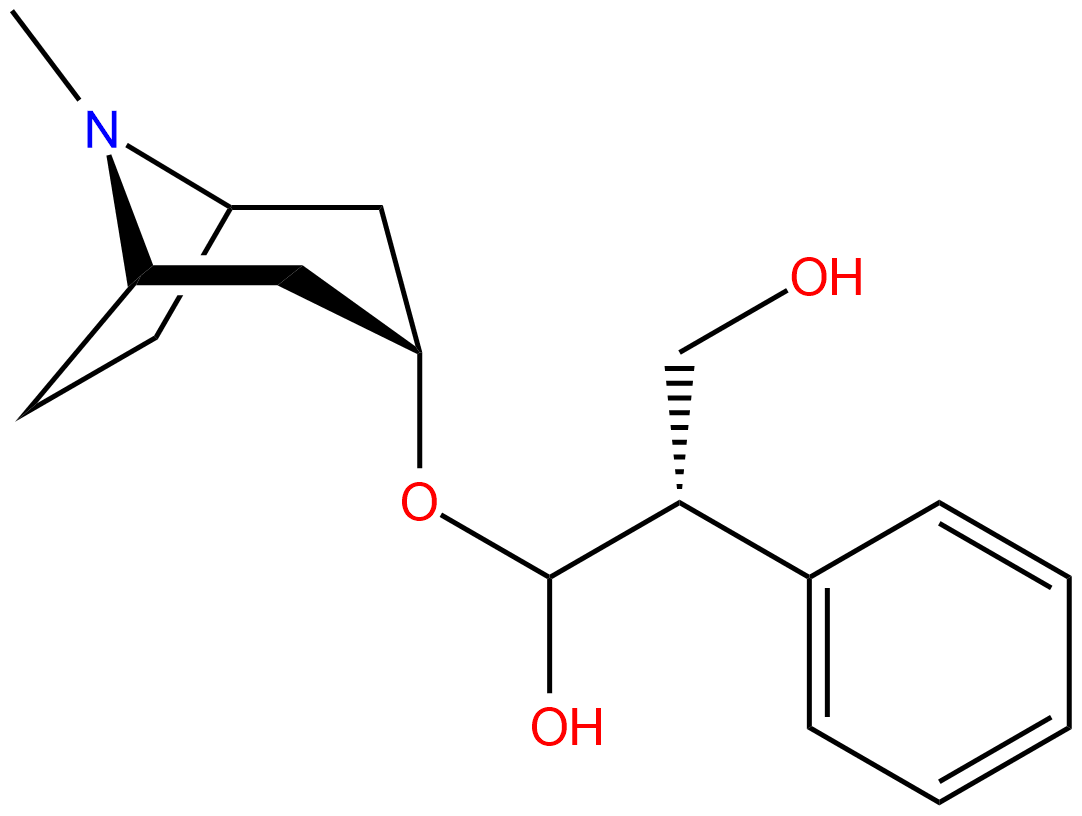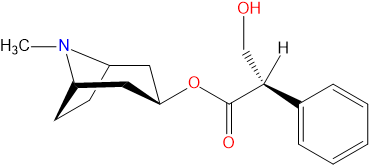Datura: Difference between revisions
>Josikins No edit summary |
>Josikins |
||
| Line 21: | Line 21: | ||
==Chemistry== | ==Chemistry== | ||
[[File:Scopolamine.png]] | |||
[[File:Hyoscyamine.png]] | |||
[[File:Atropine2.png]] | |||
==Pharmacology== | ==Pharmacology== | ||
Revision as of 17:33, 1 May 2014
| Datura | |
|---|---|
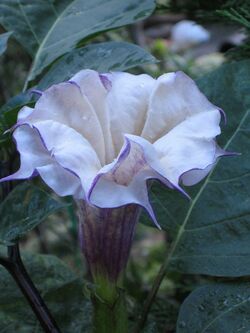 Datura metel flower. | |
| Dosage | |
| Differs wildly between plants. | |
| Duration | |
| Total Duration | 3 days |
| Onset | 60 - 120 minutes |
 |
This article is a stub. As such, it may contain incomplete or wrong information. You can help by expanding it. |
Datura is a genus of legal flowering plants which is classed as a powerful and dangerous deliriant drug. Pharmacologically, the principal psychoactive constituents of all Datura plants are tropane alkaloids such as scopolamine, hyoscyamine, and atropine, primarily in their seeds and flowers. There can be a 5:1 potency variation between plants, and a given plant's toxicity depends on its age, where it is growing, and the local weather conditions. This variation makes Datura exceptionally hazardous as a drug. Because of the presence of these substances, Datura has been used for centuries in some cultures as a poison.[1][2]
The plants precise and natural distribution seem to be throughout most of the temperate and tropical regions of the globe, owing to its extensive cultivation and naturalization. There are a total of nine different species in the Datura genus, but the two most well-known species are Datura inoxia and Datura strammonium. Both of which have been used in a shamanic context for religious purposes on most continents since before recorded history throughout the ancient Americas, Europe and India.
As a general rule, PsychonautWiki neither recommends nor discourages the use of any psychoactive, however, in the case of tropane alkaloid containing plants, we think it is important to note that an overwhelming majority of those who describe their use of Datura find their experiences extremely mentally and physically unpleasant and not infrequently physically dangerous.
Chemistry
Pharmacology
Datura is an antimuscarinic agent.
Subjective effects
Physical effects
The physical effects of datura are usually described as extremely uncomfortable. They can be broken down into nine components all of which progressively intensify proportional to dosage. These are described below and generally include:
- Increased bodily weight - The first noticeable sensation is that of having an extremely heavy body, as if the gravity has been multiplied by a thousand. This makes it extremely difficult and uncomfortable to move.
- Spontaneous tactile sensations - Users commonly report all-encompassing, sharp and extremely painful jolts of electricity that spontaneously manifest themselves in a similar rhythm to hiccups.
- Muscle cramps
- Nausea
- Dizziness
- Restless leg syndrome
- Abnormal heart beat
- Frequent urination
- Difficulty urinating - This can be described as a feeling of concrete blocking your urethra and painfully conflicts with a frequent need to urinate.
Cognitive effects
The head space of datura is described by many as generally negative and dysphoric throughout the trip, generally consisting of extreme paranoia and feelings of impending doom. It is largely confusing and disorienting often leading to a complete inability to communicate or understand normal language. It contains unique cognitive effects found almost exclusively in the deliriant class.
The most prominent of these effects include:
- Depression
- Anxiety
- Thought deceleration
- Suppression of emotion
- Suppression of information processing
- Amnesia
- Suppression of language
- Time distortion
- Paranoia
Datura does not enhance visual stimuli in the way that psychedelics do; instead they tend to degrade and decrease visual aptitude both increasing hallucination and degrading vision. These components are detailed below:
- Decreased visual acuity - This effect can result in blurry vision to the point of blindness, sometimes lasting for days after the trip itself.
- Suppression of pattern recognition
- Vibrating vision
As for visual distortions and alterations, effects experienced are detailed below:
- Visual drifting (Melting, Breathing, Morphing and Flowing) - In comparison to other hallucinogens, this effect can be described as intricate in complexity, jittery, slow and rigid in motion, static in their permanence, realistic in believability, and interactive in plasticity
- Visual haze
- After images
The effects of Datura are extremely efficient at inducing delirious hallucinations which can be broken into the two categories described below:
Auditory effects
The auditory effects of Datura are common in their occurrence and exhibit a range of effects which commonly includes:
Natural plant sources
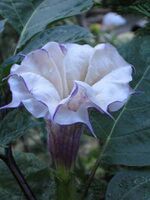
Datura is a genus of nine species of flowering plants, also known as angel's trumpets and daturas. Due to its extensive cultivation and naturalization throughout the temperate and tropical regions, it is found in most areas of the world. There are nine identified species:
- D. ceratocaula
- D. discolor
- D. ferox
- D. inoxia
- D. leichhardtii
- D. metel
- D. quercifolia
- D. stramonium
- D. wrightii
Toxicity and Harm Potential
In traditional cultures, a great deal of experience with and detailed knowledge of Datura was critical to minimize harm.[4] Many tragic incidents result from modern users ingesting Datura. For example, in the 1990s and 2000s, the United States media contained stories of adolescents and young adults dying or becoming seriously ill from intentionally ingesting Datura.[7][8] There are also several reports in the medical literature of deaths from D. stramonium and D. ferox intoxication.[9][10][11] Children are especially vulnerable to atropine poisoning, and their prognosis is likely to be fatal.[12][13]
In some parts of Europe and India, Datura has been a popular poison for suicide and murder. From 1950 to 1965, the State Chemical Laboratories in Agra, India, investigated 2,778 deaths caused by ingesting Datura.[4][14]
Lethal Dosage
The LD50 for scopolamine in humans is 2µg/kg and for atropine is 33µg/kg.
It is extremely important to note however that the potency of plants varies wildly and there is no way for the common man to accurately measure the dosage. At high enough doses Datura becomes an incredibly toxic poison that can easily result in death, making Datura the most dangerous hallucinogen out there with accidental overdoses resulting in hospitalization not unheard of.
The safest way to ensure this does not happen is to grind the dried plant matter into an extremely fine and even powder so that the active chemicals within them are distributed evenly across itself. From here you can slowly work your way up in extremely small increments until the correct dosage for that particular plant is found.
If you want to try datura despite all of its risks, you can grow it yourself using seeds purchased online or find a wild plant in your local area.
Tolerance and Addiction Potential
Tolerance forms quickly with datura use. There is no real addictive potential.
Legal Issues
Datura grows naturally and is legal to grow, sell and consume in most parts of the world.
- Australia: Datura is a Schedule I poison.
- Brazil: Possession and sale is illegal.
See Also
References
- ↑ Preissel, U.; Preissel, H.-G. (2002). Brugmansia and Datura: Angel's Trumpets and Thorn Apples. Buffalo, NY: Firefly Books. pp. 106–129. ISBN 1-55209-598-3.
- ↑ Spirit, Mind and Body in Chumash Healing | http://www.ncbi.nlm.nih.gov/pmc/articles/PMC1297503/
